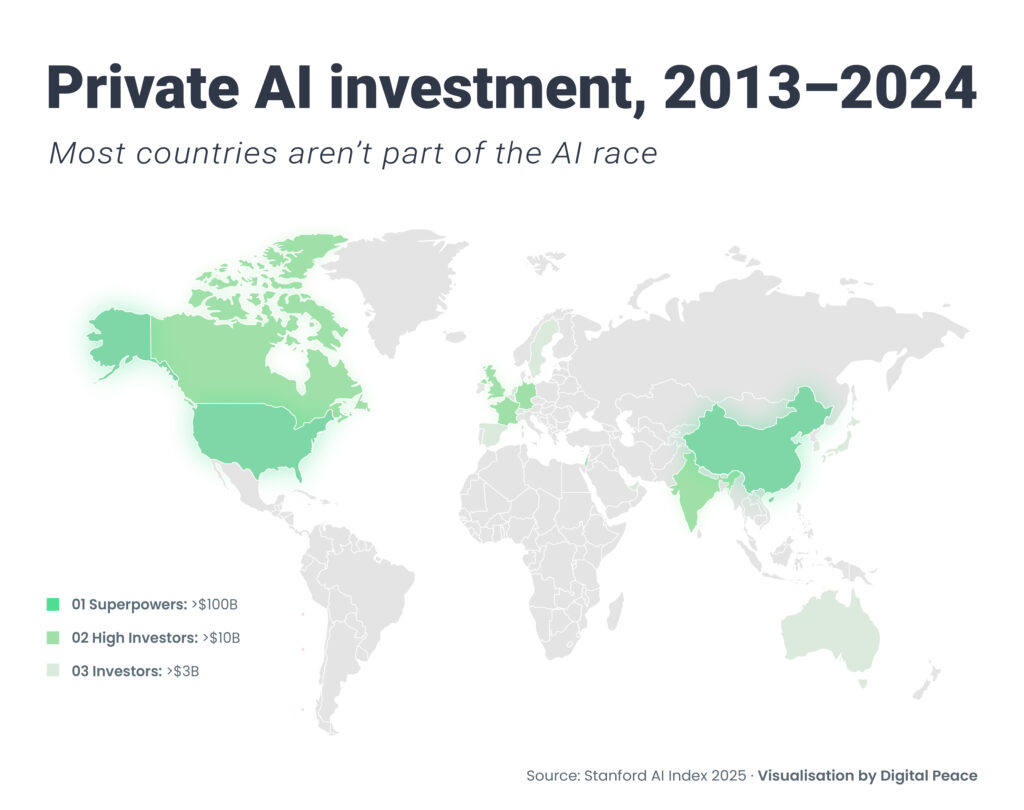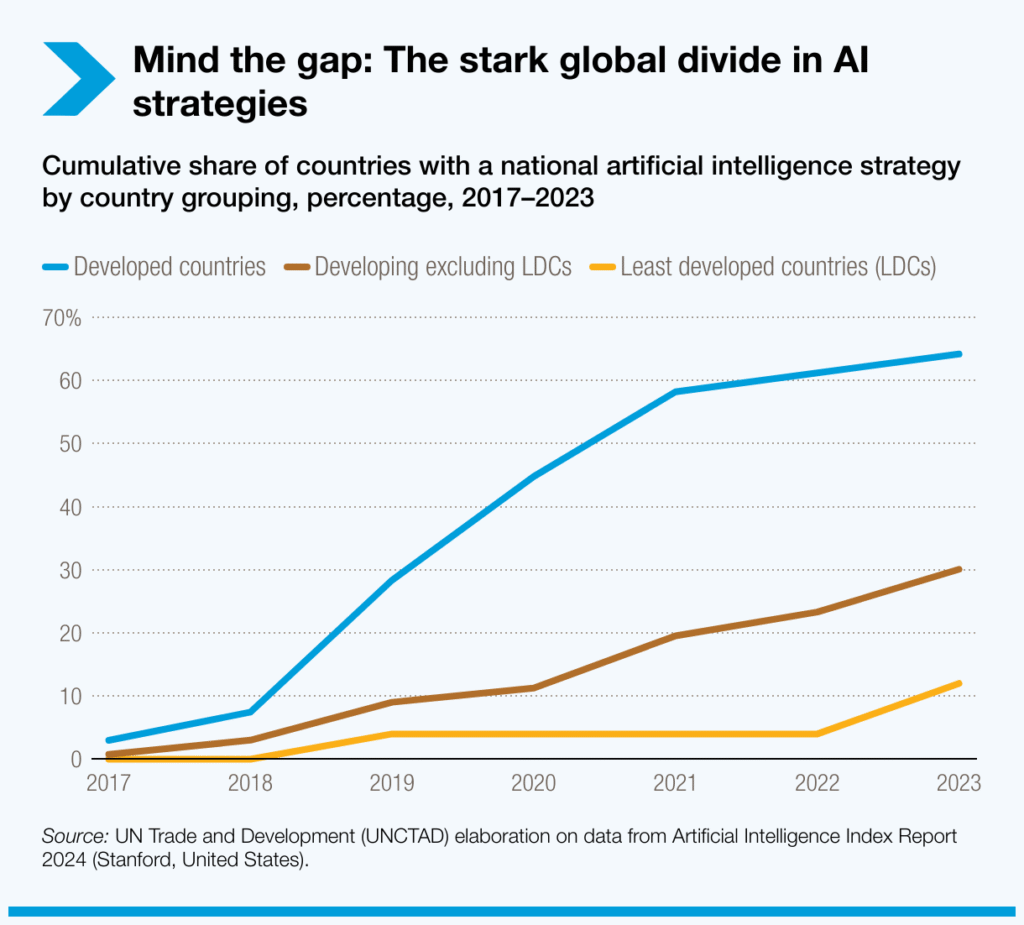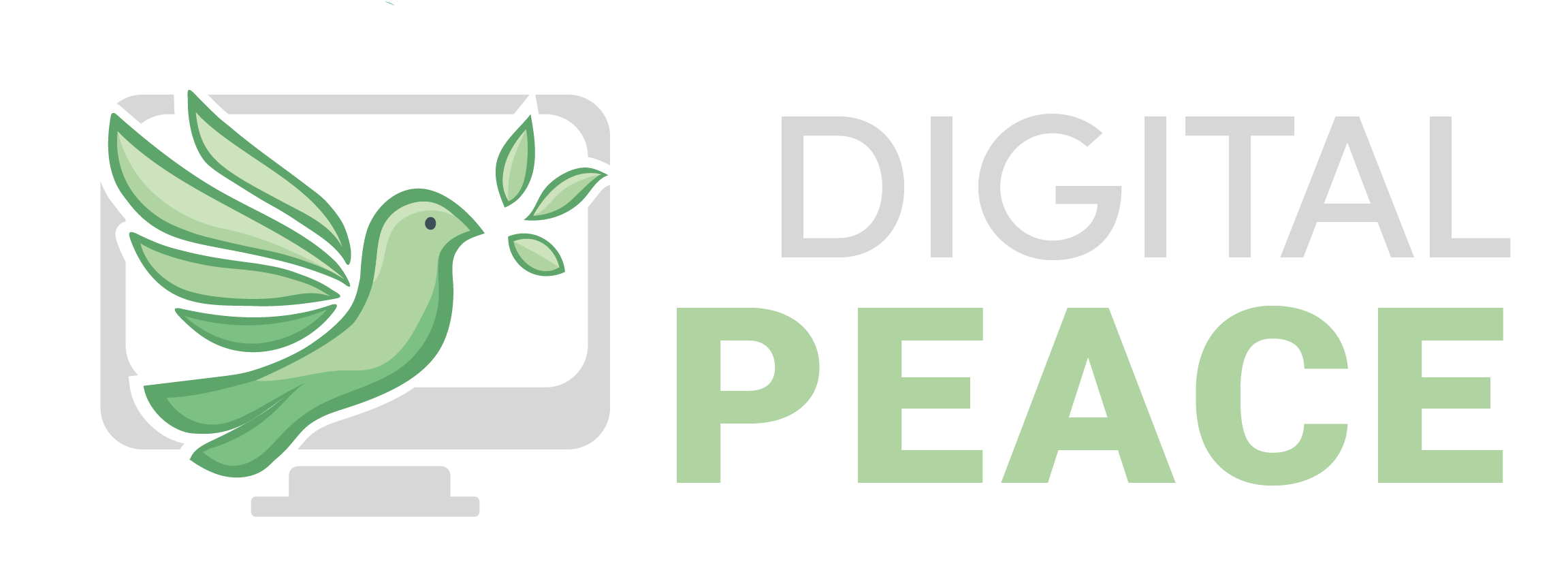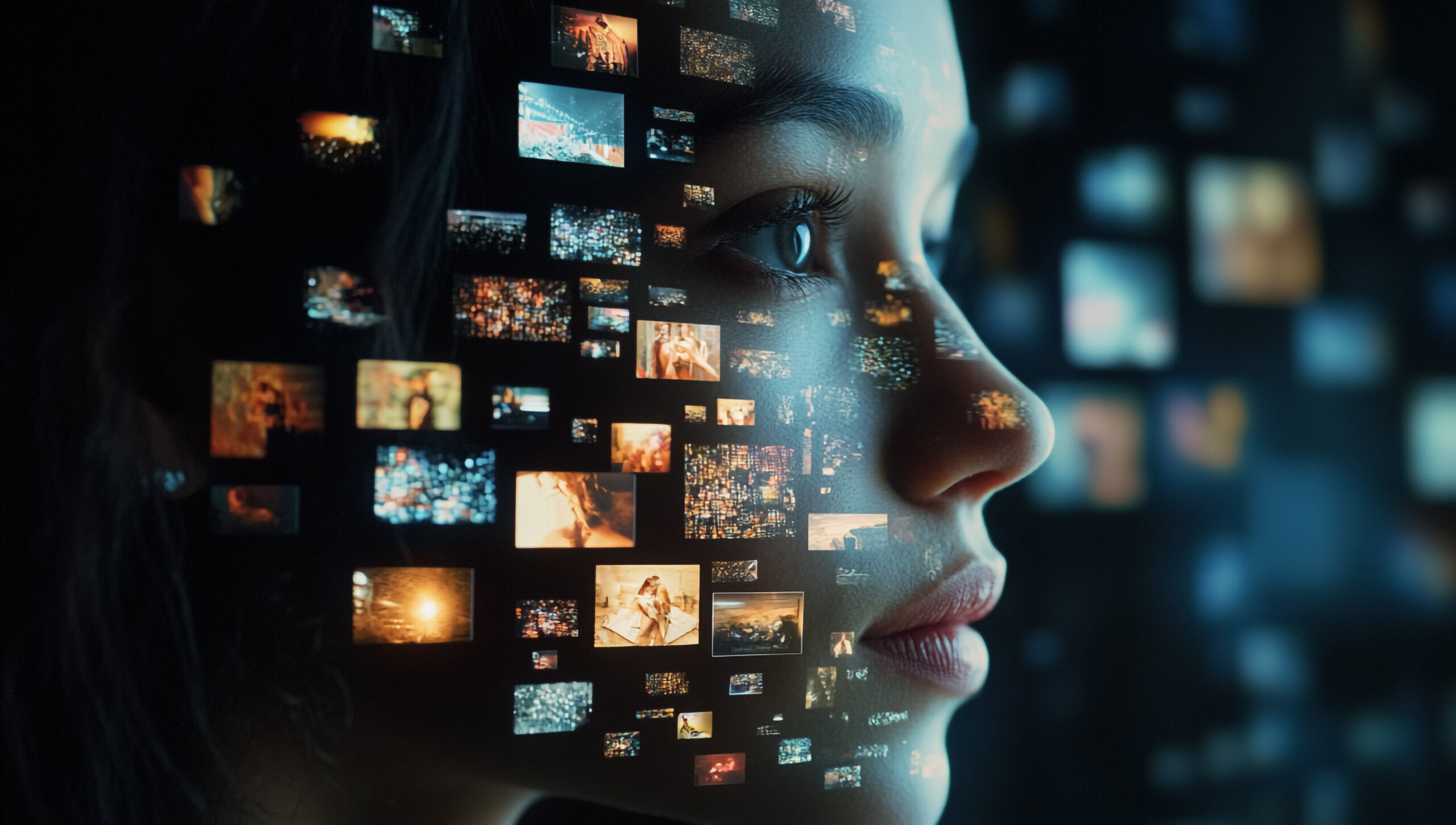AI inequality is rapidly becoming one of the defining challenges of our digital age. While technology brings significant benefits, its effects on individuals, societies, and the natural world are often paradoxical — advancing progress on one hand while causing harm on the other. Yet, the focus tends to remain on the glamour of technological advancement, with comparatively little attention paid to the negative consequences that accompany it.
In the modern world, economic growth is increasingly tied to a country’s willingness to invest in and embrace technological development. Technology has thus become not only a driver of national prosperity but also a major factor in global trade and investment trends.
In many ways, today’s tech companies have assumed a role reminiscent of colonial powers, shaping the global landscape in ways that prioritize their economic interests above all else. By creating digital infrastructures that span the globe, these corporations not only extend their reach but also cultivate a dependence on their products, which are often marketed as indispensable. This widespread integration into daily life creates a power dynamic where tech companies control not just markets, but the very fabric of society. In this process, the workforce, particularly in the Global South, is frequently exploited through low-wage labor, while these companies maintain a veneer of innovation and progress. At their core, these corporations are driven by profit, with little regard for the broader social, environmental, and political ramifications of their operations. The unchecked growth of such entities has profound implications for democracy, the environment, and marginalized communities, all of which bear the brunt of an unaccountable digital empire. 1
Digital Colonialism and the Roots of AI Inequality
This digital era has brought with it stories of rapid transformation—narratives of countries starting the digitalisation revolution through mobile banking, national ID systems, and cashless economies. India, Kenya, Brazil, Indonesia and so on are some of the champions of the mountainous quest from the global south.
However it is important not to confuse visibility with reach.
Beneath the glowing headlines lies a more complicated truth: digital growth has been uneven, and the very people who were supposed to be empowered by this revolution are often left behind. Vast segments of populations in these same countries remain excluded—without access to a stable internet infrastructure, reliable electricity, or even formal banking systems. A large number still lack the foundational documents needed to access digital services. These are not fringe exceptions; they are systemic gaps in the digital rollout.
When Access Isn’t Empowerment
This digital divide—between those who are in and those who are out—is not a footnote. It is the fault line in the foundation of what was meant to be an inclusive transformation.
And yet, even among those who do have access to smartphones and internet connectivity, another dangerous gap emerges: the absence of digital literacy and critical thinking. Because access alone does not empower—understanding does. In the absence of critical engagement, digital access becomes a conduit for misinformation.
We’ve seen this pattern play out repeatedly: viral disinformation campaigns, doctored videos, sensationalist headlines shared without context. Social media platforms—designed to connect—are increasingly weaponised to divide. This isn’t limited to any one country or demographic. The educated, urban middle class is just as vulnerable to these narratives as the digitally new. The architecture of modern digital platforms rewards outrage over accuracy, fear over facts.
Digitalisation is not the enemy—far from it. It is necessary for progress. But digitalisation without education, without independent media, without a culture of questioning, is like handing over a steering wheel to someone who has never learned to drive—and blaming them for the crash.
AI Inequality and the Repetition of Colonial Patterns
And now, just as the world is grappling with the fallout of that first digital wave, we’re standing on the precipice of another revolution: Artificial Intelligence.
Artificial Intelligence (AI) is often seen as a symbol of progress—something that promises to change the world for the better. Big tech companies talk about how AI can transform industries, make our work faster and smarter, and help solve big problems like climate change. It’s marketed as a powerful tool that can drive economic growth and reshape the way we live and work.
But behind all the hype around AI and digital progress is a much harsher truth—most of the benefits are flowing to the Global North, while the Global South is left to shoulder many of the costs. The people labeling data, moderating content, or working behind the scenes to train AI systems are often underpaid and invisible. Meanwhile, the environmental toll—think massive energy-hungry data centers and e-waste—is often pushed onto countries least equipped to deal with it. In many ways, AI isn’t breaking from the past—it’s repeating old patterns of exploitation, deepening AI inequality in a new, high-tech form. 2
Instead of building a more inclusive and democratic technological future, AI is reinforcing old patterns of inequality. What we’re seeing is a kind of digital colonialism—where a handful of countries and corporations reap the benefits, while the risks, errors, and unintended consequences are pushed onto the world’s most vulnerable communities. 3
AI Literacy and the Widening Gap of AI Inequality
AI is poised to reshape how we work, learn, communicate, and make decisions. But just like digitalisation, this next frontier is also emerging with deep imbalances—resulting in a rapidly growing form of AI inequality. Countries in the global north—with robust infrastructure, research funding, and policy frameworks—are already setting the pace. While countries with ample resources are investing in educating their populations to identify misinformation and engage critically with AI4, the global south is often left to bear the brunt of its consequences, effectively becoming a testing ground for its unintended impacts.5 And this time, the consequences could be even more profound—especially when we consider the vast disparities in global AI investment, a reflection of deepening AI inequality.
According to the 2025 AI Index Report, the United States leads by a wide margin in private AI investment, with $470.9 billion — nearly four times more than China ($119.3 billion), and vastly ahead of the United Kingdom ($28.2 billion) $470.9 billion, followed by China ($119.3 billion) and the United Kingdom ($28.2 billion), which rank second and third. Canada and Israel each invest around $15 billion, while Germany and India follow
closely with $11.3 billion and $11.1 billion, respectively. France contributes $9 billion, and both South Korea and Singapore invest $7.3 billion.6 While many countries are increasing their AI funding, the majority of global private AI investment remains highly concentrated in a small group of leading economies.

Countries in the Global South-including those in Africa-receive only a small fraction of this capital, accounting for just 0.3% of projected global AI investments for 2025, despite having some of the fastest-growing markets and a surge in local innovation. 7

These figures highlight more than just economic leadership—they reveal a widening AI inequality in who has the power to shape, regulate, and benefit from AI. The risk, then, is clear: without inclusive investment in AI literacy and infrastructure, the global south will not just lag behind in innovation—it will bear the brunt of AI’s misuses.
It’s ironic, really. A tool meant to connect, create, and democratise knowledge is now poised to deepen existing divides. And unless we begin to address this imbalance—by acknowledging the privilege of those with access and investing meaningfully in those without—we risk repeating the same mistakes we made with digitalisation—and entrenching AI inequality on a far more dangerous scale.
The AI of Silicon Valley is not the AI of New Delhi, Lagos, Jakarta, or La Paz—and that contrast, if left unaddressed, will shape the future of global AI inequality.
AI is set to grow at an unprecedented pace, becoming ever more convincing and seamlessly integrated into the very fabric of our societies. As it does, it will inevitably transform entire sectors. Yet, this transformation is occurring against the backdrop of an already troubling reality: the concentrated ownership of social media platforms, mainstream news outlets, and political narratives, alongside the steady decline of independent, free media—an essential public good. When we link these dynamics with the rapid proliferation of AI technologies, framed under the banner of innovation, we uncover a looming risk: that the greatest harm may fall upon those least equipped to navigate this new reality—ordinary consumers and the untrained individuals who become subject to AI’s influence rather than participants in its shaping.
Rethinking Power: Toward Democratic AI Governance
There is, admittedly, no ready-made solution to this complex challenge. However, it is becoming increasingly clear that decoupling AI, or at least aspects of its development and deployment, from the purely capitalist model of business could be essential. Such a shift could act as a catalyst not only for a more equitable human future but for the well-being of the planet itself. Any meaningful governance and integration of AI must be undertaken through a political lens, one that critically centers equity—a foundational yet persistently overlooked principle in our technological ambitions. It demands that we revisit and redefine the structures of ownership, access, and accountability in an age where technology and power are becoming ever more entwined.
The ability to identify AI-generated content—whether visual, textual, or otherwise—is not instinctive. It is a skill developed through logical reasoning, critical thinking, and, most importantly, education. While there are various entry points along the journey to understanding and contextualising AI outputs, being able to consume such content without being misled is, in many ways, a privilege. As we navigate this transformative shift, we must acknowledge the unevenness of that privilege. Building an alternative, more inclusive narrative around AI begins by recognising this imbalance and actively working to bridge it.
A just technological future requires not just access, but genuine autonomy—a direct response to the dangers of rising AI inequality, and a call to confront the systems that perpetuate it. Without democratizing the design and governance of digital systems, we risk creating tomorrow’s inequalities today.
It’s time to rethink the future we’re building.
References
- Nothias, T. (2025). An intellectual history of digital colonialism. Journal of Communication. https://doi.org/10.1093/joc/jqaf003
- F. Regilme, D. S. S. (2024). Artificial Intelligence Colonialism: Environmental Damage, Labor Exploitation, and Human Rights Crises in the Global South. SAIS Review of International Affairs, 44(2), 75-92. https://muse.jhu.edu/pub/1/article/950958/pdf
- Jem Bartholomew, J. (2023, August 29). Q&A: Uncovering the labor exploitation that powers AI. Columbia Journalism Review. https://www.cjr.org/tow_center/qa-uncovering-the-labor-exploitation-that-powers-ai.php
- Teach AI. (2024). Resources for Policy and Guidance on AI in Education. Teach AI. https://www.teachai.org/policy-resources
- Al Jazeera. (2025, January 28). Finland teaches media literacy to fight fake news and disinformation. YouTube. Retrieved April 27, 2025, from https://www.youtube.com/watch?v=UZV9uw4usEE
- Stanford Institute for Human-Centered Artificial Intelligence (HAI). (2025). Artificial Intelligence Index Report 2025. https://hai-production.s3.amazonaws.com/files/hai_ai_index_report_2025.pdf
- UN Trade and Development (UNCTAD). (2025, April 7). AI’s $4.8 trillion future: UN Trade and Development alerts on divides, urges action. UN Trade and Development (UNCTAD). https://unctad.org/news/ais-48-trillion-future-un-trade-and-development-alerts-divides-urges-action







